How to make an alcohol stove
A small, lightweight alcohol stove can be made from two soda cans and, in this design, two screws. I've used it while burning methyl hydrate, more commonly known as methanol, which is available in hardware stores. Below I'll show you step-by-step how to make it, both on this page and in a video below.
In the photos below you can see the alcohol stove but you can also see that I was using it to make a minion spin as a Hero's steam engine, also shown in the video below.
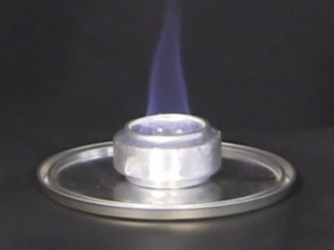
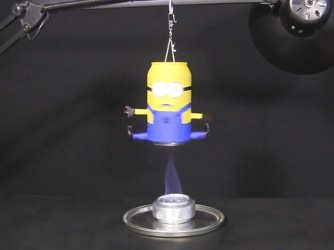
How to make an alcohol stove
Step 1. Get two soda cans.
Step 2. Draw a line around them both at least 1 1/8" or 3 centimeters from the bottom.
Step 3. Cut the bottoms away from both. Do this gently so that you don't bend the sides and create dents. You want the sides to be smooth, well rounded.
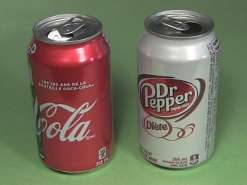
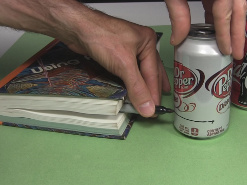
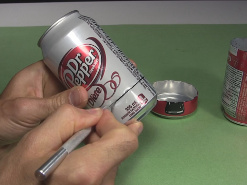
Step 4. Sand the top edges so that they're easier to work with. Again, be gentle since we want the sides to be smooth, well rounded.
Step 5. Select one of the can bottoms and poke small holes where the flames will come out. I'm using a hand punch for this, but use whatever you have available. The sharp point of a compass (the tool for drawing circles) will work for example. You could also drill them with around a 1/16" drill bit. In my case I did it in the center area of the can and I made eight of them. That's because I wanted the flames to be in the center since I was making it to power a Hero's steam engine (see the video below.) Most people put the holes on the outer edge, as illustrated below since they're just using it for cooking purposes and the bottom of their cooking pot is larger than the stove.
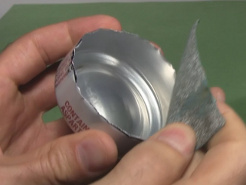
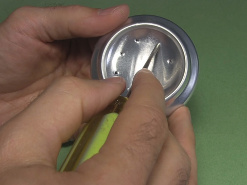
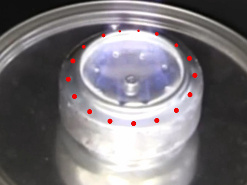
Step 6. Drill a larger hole in the center for filling the stove with alcohol. After filling, you'll be plugging the hole with a screw so make the hole the right size for whatever screw you have.
Step 7. If you're putting the holes for the flames to come out of in the center area of the can like I did in step 5 then drill another hole at the edge. If you're putting the holes on the outer edge instead like I also talked about in step 5 then you probably don't need this other hole. Its purpose is for air to escape while filling the stove with alcohol. It can be the same size as the fill hole. A screw will be plugging this one too after you've filled the stove.
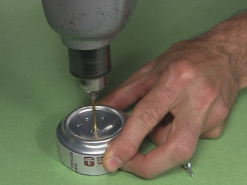
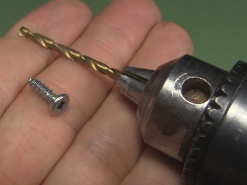
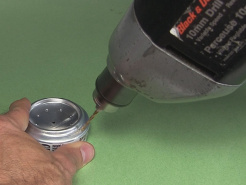
Step 8. Bend the edges of the can that has the holes you made. Bend only near the edge, making sure to leave a lot of the side smooth and well rounded.
Step 9. Insert the can with holes in it into the other can. This is hard to do since they're both the same size. The goal is to have one inside the other but with as much of the sides smooth and well rounded. If you have dents in the sides then the flame will come out of the upper edge where the dents are.
Some try putting the can with holes in it in the freezer for a few minutes to shrink it, and even heat up with can with no holes in it to grow it and then put them together. If it works for you then great. It didn't work for me.
One trick, that I didn't do, is to first put a high temperature sealant around the side of the can that has holes in it first, and then put it in the other can. That will tollerate dents better. Since I didn't do this, I had to make a few of these before being successful. Examples of some sealants are:
- JB-Weld,
- high temperature silicone,
- high temperature gasket sealant.
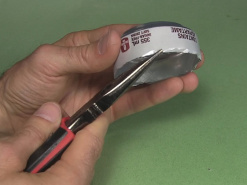
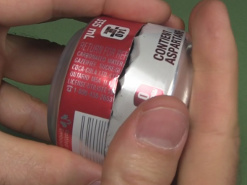
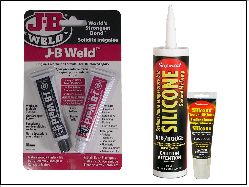
And now you have your finished alcohol stove. You can see that I also sanded away any branding leaving a nice metal looking finish.
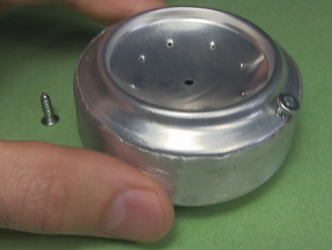
Lighting the alcohol stove
Lighting the alcohol stove isn't easy. That's because it burns on the fumes coming out of the flame holes and not on the liquid fuels inside. This causes it to burn longer than it otherwise would. Mine burns for around a half hour. The fumes are a result of the alcohol being heated.
But to get enough fumes you first have to heat up the stove and that takes a few minutes.
Step 1. With no screws in either the fill hole or the edge hole, pour your alcohol in. In my case I used methyl hydrate (methanol), a type of alcohol, from a hardware store. Rubbing alcohol doesn't work well at all. If fuel starts coming out of the fill hole then you've put too much.
Step 2. Plug the fill hole and the edge hole by putting in the screws.
Step 3. Make sure there is no flame before doing this step. There won't be any flame the first time, but this step will be repeated a few times. I check by looking first and then putting my hand over the top to feel for heat. When you're sure there's no flame, pour more alcohol in the center. Due to surface tension due to the small size of the flame holes, the fuel will not go into them. Don't overflow the center area.
Notice in the photos below that I put a metal tray underneath since the stove will get hot and I don't want to damage the table. In my case the tray is simply a paint can lid.
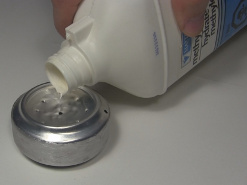
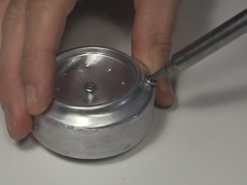
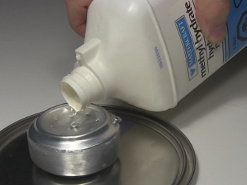
Using a lighter to heat up the side of the stove can also help to speed up heating.
Step 5. In the photo below you can see individual flames coming out of the small flame holes. In this case they also combine to make a bigger flame since they're so close together. This is the goal. But it won't happen right away. If the flame simply goes out then make sure the flame is out and then go back to step 3.
If you do get individual flames then the stove is lit and will stay lit for around a half hour if it's the same size as mine. In my case I have to go back to step 3 around six or seven times before I get the individual flames.
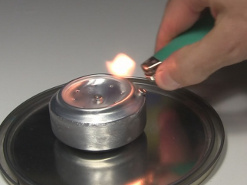
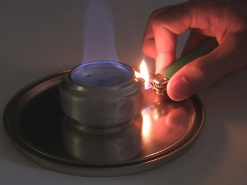

Video - How to Make an Alcohol Stove and Minion
In this video I show step-by-step how to make the alcohol stove, followed by some fun using it to make a minion spin as a Hero's steam engine.
